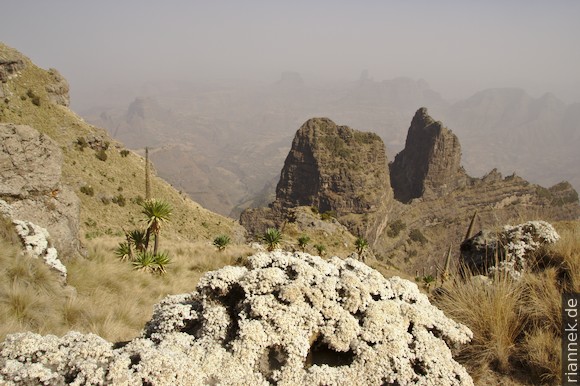
The Simien Mountains in Ethiopia are the remains of an ancient shield volcano (cf. my book The Formation of Mountains). It is largely a grassy plateau and gentle ridges, but at the edges it drops off abruptly in a steep escarpment into the lowlands. The escarpment in the northwest, the most visited part of the Simien National Park, is particularly spectacular. The landscape reminds me a little of the escarpment of the East African Rift in Tanzania in the area of my diploma thesis, because the steep scarp is divided into steps by individual lava flows and it is overgrown (now in the dry season) with similar dry grass. However, in the Simien Mountains the escarpment is more dissected, it jumps back and forth and there are some rocky mountains in front.
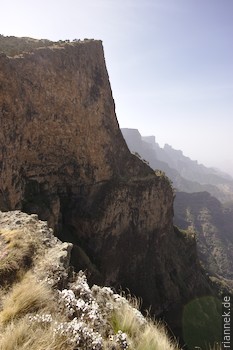
The rocks are related to the formation of the East African Rift Valley (see also my book The Formation of Mountains). Even before the actual rift formation, enormous quantities of basalt lava erupted in the Oligocene about 30 million years ago; these flood lavas covered a huge area with a thick layer of rock, today’s highlands of Ethiopia. A little later, several large shield volcanoes were formed on the plateau, the Simien Mountains are the remains of one of them.
In the Miocene, strong uplift began due to the dynamic pressure of the mantle plume that was ascending below. A region with a diameter of about 1000 km was affected, the so-called Afar Dome or Ethiopia Dome. Now subsidence of the Ethiopian Rift (in the south) and the Afar Triangle (at the triple point with the Red Sea and the Gulf of Oman) began, further raising the rift shoulders.

Unfortunately, we were very unlucky as far as visibility was concerned. A sandstorm with dust from the Sahara made it so hazy that we could hardly see the lower edge of the escarpment on the first day. The visibility did get a little better day by day, but no comparison to the photos I had seen before. Apart from that, photos taken right after the rainy season (in October) are much more impressive because everything is green.
If you want to hike in the Simien Mountains, you have to have at least one ranger (scout) armed with a Kalashnikov with you, usually a guide and a cook and an assistant cook and a muleteer also come along…
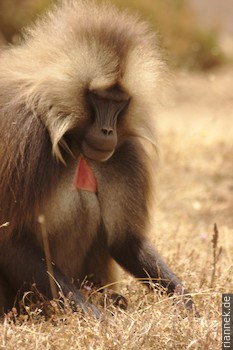
We drove from Debark (with the national park administration) into the national park to just behind Simien Lodge and began the hike along the escarpment, as I said, with extremely poor visibility. On the way we made our first acquaintance with the geladas, an endemic monkey species that looks similar to baboons. The males have a conspicuous heart-shaped spot on their chest. Almost every day we encountered a group of these monkeys. In the afternoon we reached Camp Sankaber, which is situated on a narrow ridge between the northern escarpment and a gorge cut towards the south.

On the second day, we hiked along the ridge to the Jinbar Waterfall, which cascades down the northern escarpment in one of the most beautiful places (however with little water flowing towards the end of the dry season and the haze still severely limiting visibility). Later we walked across the grassy plateau to Geech Camp, where many of the strange giant lobelia grow. In the evening we climbed Kadavit, a peak on the escarpment. At sunset, a huge herd of monkeys came up from the plateau and passed right by us to descend to the small sleeping caves in the escarpment.
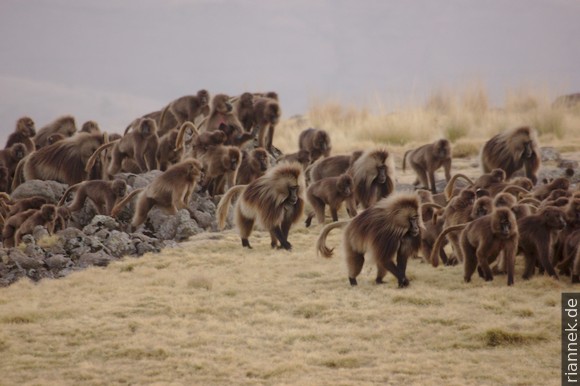
The next morning we hiked to the best vantage point, a rocky pulpit called Imet Gogo. Two rock towers are below us, and more monoliths can be glimpsed in the haze in the distance. To reach Chenek camp from here, we had to follow the escarpment down a good distance into the upper end of a valley, continue following the escarpment up onto the next mountains and down the other side. Chenek is right next to the edge, with a wonderful viewpoint, but also right on the unpaved road over which heavy trucks constantly rumble (a new road going around the mountains is under construction).
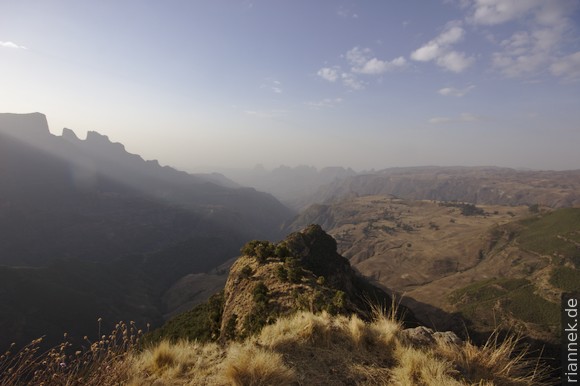
The next day we climbed Mount Bwahit (4430 m), after all the second highest mountain in the Simien Mountains and one of the highest in the country. Unfortunately, the road pass is only a little below the summit and our way crossed several times the serpentines cut into the slope, over which the trucks tortured themselves enveloped in a huge cloud of dust. At least we spotted a few ibex (the endemic species Ethiopian ibex or Walia) while looking over a rocky ledge. From the summit, the highest mountain in the Simien Mountains (and the highest in the country), Ras Dashen, can also be seen standing at the other end of the mountain range.
On the morning of the 5th day we were picked up by a minibus and drove back to Debark, by lunch we were already in Gondar.